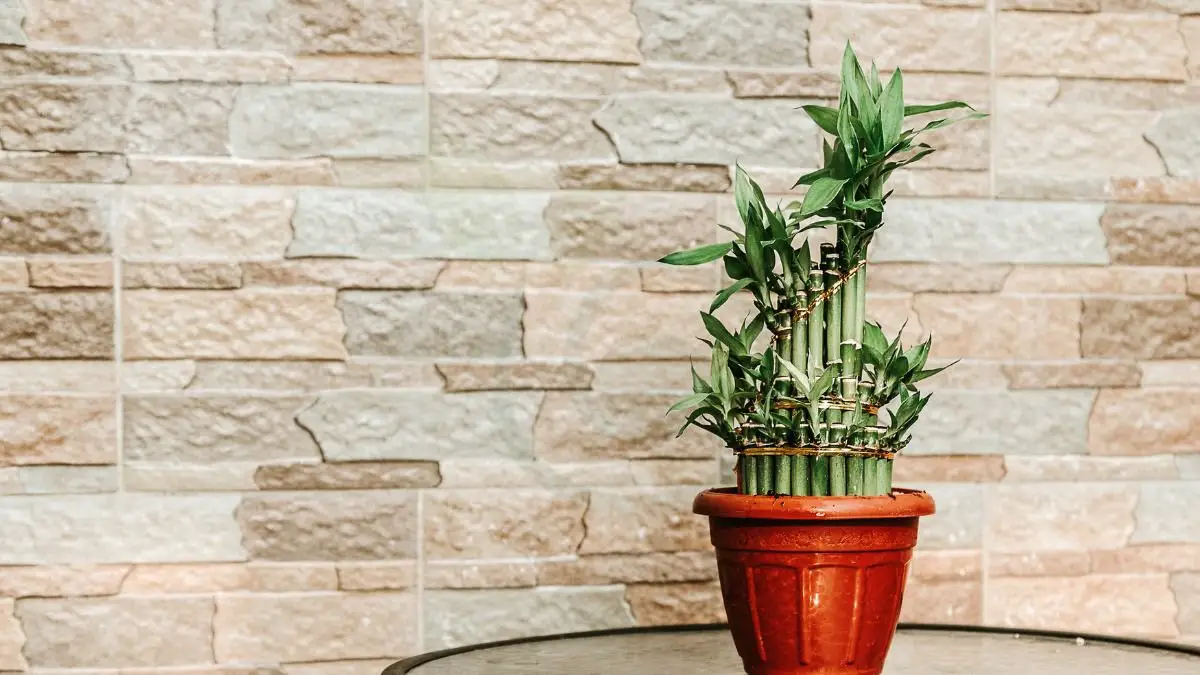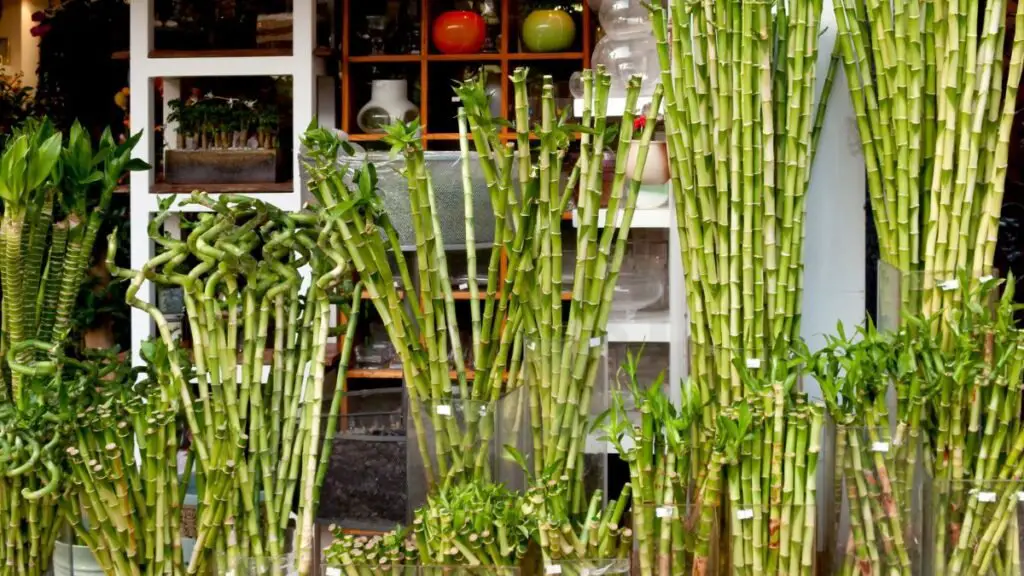
Lucky bamboo is an easy-to-care-for plant, and knowing how to trim lucky bamboo properly, including leaf tips, leaves, and roots, can ensure its health and beauty. As an expert in gardening and plant care, I'm here to guide you through the steps of soil planting, so you can confidently maintain your lucky bamboo and keep an eye on the leaf tips.
To trim lucky bamboo for houseplant care, start by identifying unhealthy or overgrown stems with disinfected shears. Use clean, sharp scissors or pruning shears to cut the stems just above a node, where new growth will emerge. Remove any yellowing or damaged leaves as well. It's important to cut leaves and sprouts only as much as necessary in houseplant care to maintain the plant's shape and health. Regular pruning encourages new growth and keeps the plant looking its best.
For further tips on caring for lucky bamboo and ensuring its longevity, consider exploring proper watering techniques, suitable lighting conditions, and the importance of using the right type of water. By implementing these strategies, you can cultivate a thriving and vibrant lucky bamboo plant in your home or office space.
Key Takeaways
- Understand the needs of your lucky bamboo before trimming to ensure healthy growth.
- Prepare your tools and workspace before trimming to make the process smoother.
- Time your trims during the plant's active growth period for optimal results.
- Follow a step-by-step trimming guide to avoid damaging your lucky bamboo.
- Prune your plant strategically to promote new growth and maintain its shape.
- Water the stalks and provide proper aftercare following trimming to support your lucky bamboo's recovery.
Understanding Lucky Bamboo

Growth Habits
Lucky bamboo stalks grow slowly, thriving in water or soil and indirect sunlight. It requires minimal care.
The plant's growth is steady, making it an ideal choice for those seeking a low-maintenance green companion.
Health Benefits
Purifying the air, lucky bamboo creates a healthier indoor environment by removing toxins.
According to Feng Shui principles, this plant attracts positive energy, fostering a sense of well-being and harmony with water.
Ideal Conditions
For optimal growth, ensure lucky bamboo is placed in warm temperatures with indirect sunlight.
Regular watering is essential, but be cautious not to overwater as it can lead to root rot.
Preparing for Trimming
Tools Needed
Pruning shears are essential for trimming lucky bamboo, ensuring clean and precise cuts. A sharp knife can also be used for more delicate trimming tasks. To propagate new plants, you will require pebbles and distilled water to encourage root growth.
Sanitization Practices
Before and after trimming, it is crucial to disinfect your tools to prevent the spread of diseases among lucky bamboo plants. Clean tools not only maintain plant health but also promote faster healing after trimming. Utilize rubbing alcohol to sanitize pruning shears effectively.
Identifying Canes
Lucky bamboo canes are easily distinguishable by their smooth texture and vibrant green color. When selecting canes for trimming, prioritize those that appear healthy and robust. Identifying the right canes ensures successful trimming without harming the plant's overall well-being.
Timing Your Trims
Growth Phases
Lucky bamboo undergoes slow growth phases, potentially experiencing stunted growth periods. Regular trimming is key for promoting healthy growth cycles.
Seasonal Considerations
Adjust care for lucky bamboo based on seasonal changes. In winter, reduce watering frequency, while in summer, provide more indirect sunlight.
Step-by-Step Trimming Guide
Cutting Techniques
Angle Cuts
- Trim lucky bamboo at a 45-degree angle to promote new growth.
- Angled cuts prevent water accumulation, ensuring plant health.
- New shoots will emerge from the cut area, enhancing the plant's appearance.
Clean Cuts
- Ensure cuts are smooth and even to prevent damage.
- Clean trimming techniques maintain the overall well-being of the plant.
- Regular pruning encourages healthy growth and vitality.
Removing Dead Parts
Pruning dead leaves promptly helps the plant thrive.
- Prune yellowing stems to stimulate fresh growth effectively.
- Discard mushy stalks to prevent rot and maintain plant vigor.
Shaping Canes
- Trim offshoots for a tidy appearance and balanced growth.
- Shape canes by cutting at varying heights for visual appeal.
- Maintaining lucky bamboo's aesthetic appeal is crucial for its overall beauty.
Pruning for Growth
Encouraging New Shoots
Trim straggly offshoots to promote new growth. Prune offshoots close to the main stalk. Providing proper care encourages new shoots.
Controlling Height
Trim lucky bamboo to control its height. Regular pruning helps maintain the desired height. Shorten tall canes for a balanced look.
Aftercare Tips
Watering Needs
Lucky bamboo thrives when its roots are consistently moist. To maintain optimal growth, ensure to change the water weekly to prevent stagnation. adjust watering frequency based on the surrounding environmental conditions.
Fertilization
When fertilizing lucky bamboo, it is best to use a diluted liquid fertilizer to provide essential nutrients. Remember to fertilize sparingly to avoid overfeeding the plant, especially during the growing season. This practice helps in promoting healthy growth and vibrant foliage.
Sunlight Exposure
For proper growth, position your lucky bamboo in an area with indirect sunlight. Direct sun exposure can lead to leaf scorching; hence, it is crucial to avoid placing the plant under direct sunlight. To ensure uniform light distribution, make sure to rotate the plant occasionally.
Troubleshooting Common Issues
Yellowing Leaves
Yellowing leaves signal potential problems with your lucky bamboo. Act promptly to address this issue. Check if you are overwatering or underwatering the plant, as improper watering can lead to yellow leaves. To maintain the plant's health, trim any yellowed tips.
Stunted Growth
If you notice stunted growth in your lucky bamboo, it's crucial to identify the root causes. Adjust the care routine by ensuring adequate sunlight, proper watering, and occasional fertilization for optimal growth. Regular trimming of the plant can stimulate new growth and help overcome stunted development.
Advanced Techniques
Propagation from Cuttings
Propagation of lucky bamboo involves propagating leafy offshoots in water until roots develop, then transferring them to a vase for growth. This method allows for easy and efficient multiplication of your plants.
- Propagate lucky bamboo by snipping off healthy offshoots.
- Place these cuttings in a container filled with water.
- Monitor the development of roots, ensuring they are strong before transplanting.
Soil vs. Water Growth
Choose between soil or water growth based on your preference. Lucky bamboo thrives in both mediums, providing flexibility for different care routines. Water growth is particularly popular due to its simplicity and ease of maintenance.
- Opt for soil if you prefer a more traditional approach.
- Water growth requires changing the water every few weeks for optimal health.
- Consider using fertilizers specifically formulated for lucky bamboo to enhance growth.
Inspirational Ideas
Decorative Arrangements
Enhance your space with aesthetically pleasing displays of lucky bamboo. Vary the heights to create visual interest and depth. Utilize decorative containers to add a personalized touch to your arrangement.
Pairing lucky bamboo with other houseplants can result in a harmonious indoor garden display. Consider the plant compatibility to ensure all plants thrive together. This combination can elevate the overall aesthetic appeal of your living space.
Combining with Other Plants
Mixing lucky bamboo with different types of houseplants can lead to a visually appealing indoor garden. Ensure that the plants you choose are compatible to promote optimal growth. The blend of various plants can create a serene and refreshing ambiance in your home.
Final Remarks
You've learned how to care for your lucky bamboo through trimming, ensuring its health and vitality. By understanding the plant's needs, preparing adequately, and timing your trims correctly, you can promote growth and shape its appearance. Remember to follow the step-by-step guide, implement advanced techniques when necessary, and troubleshoot any issues that may arise. After trimming, provide proper aftercare to support your lucky bamboo's recovery and continued well-being.
Incorporate these practices into your routine to maintain a flourishing lucky bamboo plant that adds beauty and positivity to your space. Share your newfound knowledge with fellow plant enthusiasts and continue exploring inspirational ideas to elevate your gardening skills further. Your dedication will be rewarded with a thriving and visually appealing lucky bamboo plant in your home or office.
Frequently Asked Questions
How often should I trim my lucky bamboo?
Trim your lucky bamboo every 2-3 months to maintain its health and shape. Regular trimming encourages new growth and prevents overcrowding in the plant.
Can I use regular scissors to trim lucky bamboo?
Yes, you can use clean, sharp scissors or pruning shears to trim your lucky bamboo. Ensure the tools are sanitized to prevent any infections on the plant.
What is the best time of day to trim lucky bamboo?
Trim your lucky bamboo in the morning when it is actively growing. This allows the plant to recover during the day, utilizing sunlight for healing and growth.
Should I remove yellow leaves while trimming lucky bamboo?
Yes, remove yellow or damaged leaves while trimming your lucky bamboo. This helps improve the overall appearance of the plant and promotes healthy growth.
How do I encourage new growth after trimming my lucky bamboo?
After trimming, place your lucky bamboo in a location with indirect sunlight, change its water regularly, and ensure it receives proper care. New shoots will emerge within a few weeks.
Image Source: Paid image from CANVA



